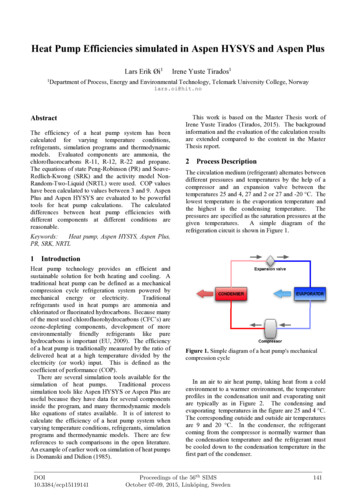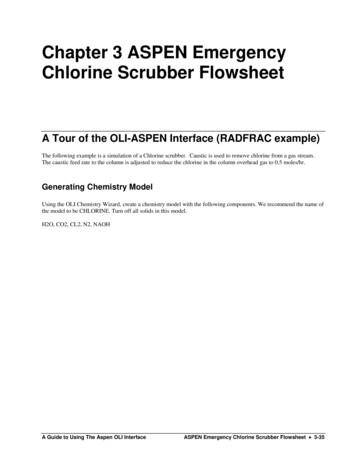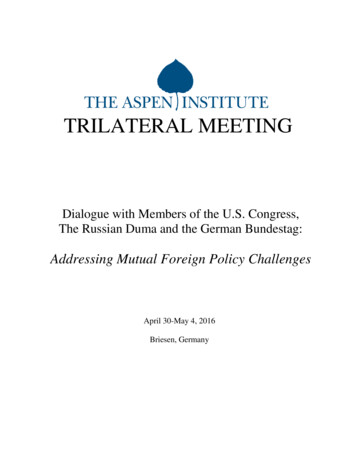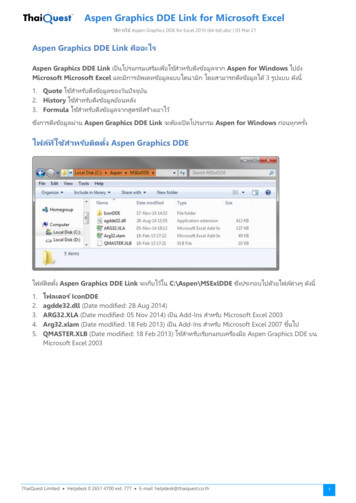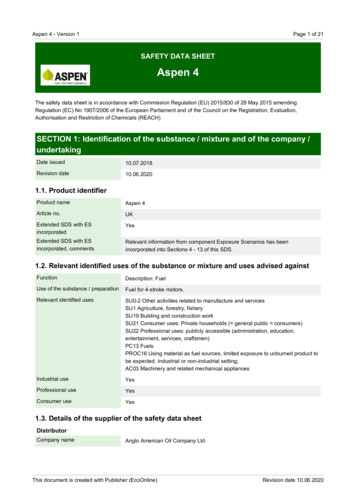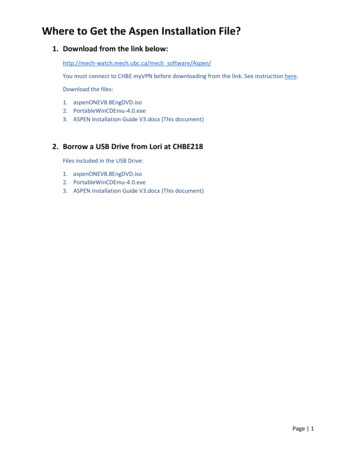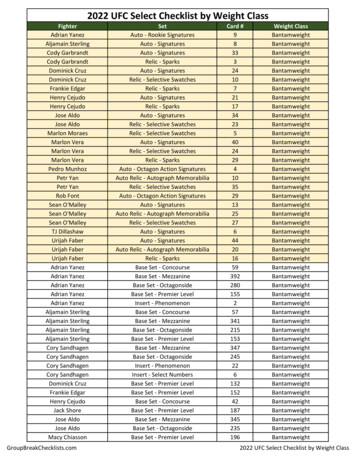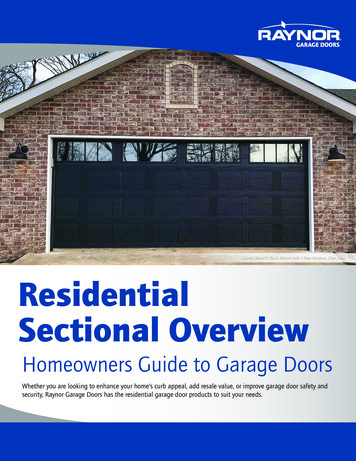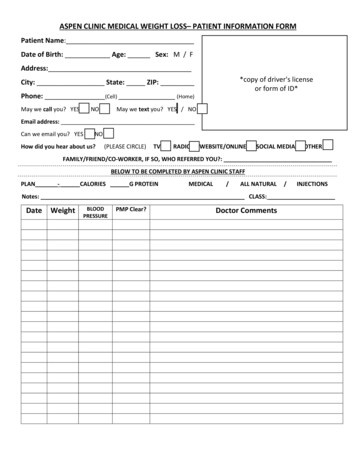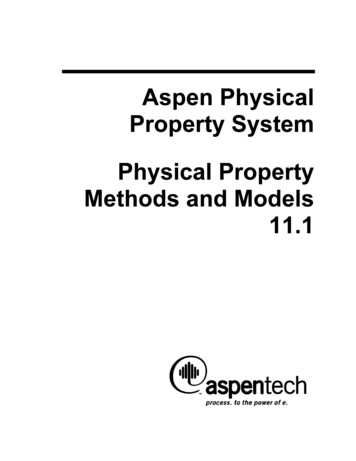
Transcription
Part Number: Aspen Physical Property System 11.1September 2001Copyright (c) 1981-2001 by Aspen Technology, Inc. All rights reserved.Aspen Plus , Aspen Properties , Aspen Engineering Suite , AspenTech , ModelManager , the aspen leaf logo andPlantelligence are trademarks or registered trademarks of Aspen Technology, Inc., Cambridge, MA.BATCHFRAC and RATEFRAC are trademarks of Koch Engineering Company, Inc.All other brand and product names are trademarks or registered trademarks of their respective companies.This manual is intended as a guide to using AspenTech’s software. This documentation contains AspenTechproprietary and confidential information and may not be disclosed, used, or copied without the prior consent ofAspenTech or as set forth in the applicable license agreement. Users are solely responsible for the proper use of thesoftware and the application of the results obtained.Although AspenTech has tested the software and reviewed the documentation, the sole warranty for the softwaremay be found in the applicable license agreement between AspenTech and the user. ASPENTECH MAKES NOWARRANTY OR REPRESENTATION, EITHER EXPRESSED OR IMPLIED, WITH RESPECT TO THISDOCUMENTATION, ITS QUALITY, PERFORMANCE, MERCHANTABILITY, OR FITNESS FOR APARTICULAR PURPOSE.CorporateAspen Technology, Inc.Ten Canal ParkCambridge, MA 02141-2201USAPhone: (1) (617) 949-1021Toll Free: (1) (888) 996-7001Fax: (1) (617) 949-1724URL: http://www.aspentech.comDivisionDesign, Simulation and Optimization SystemsAspen Technology, Inc.Ten Canal ParkCambridge, MA 02141-2201USAPhone: (617) 949-1000Fax:(617) 949-1030
ContentsFor More Information.viiiTechnical Support.viiiContacting Customer Support .ixHours .ixPhone .ixFax .xE-mail .xOverview of Aspen Physical Property Methods1-1Overview .1-1Thermodynamic Property Methods .1-2Equation-of-State Method .1-3Activity Coefficient Method.1-8Equation-of-State Models.1-20Activity Coefficient Models .1-29Transport Property Methods.1-32Viscosity and Thermal Conductivity Methods.1-32Diffusion Coefficient Methods.1-33Surface Tension Methods .1-34Nonconventional Component Enthalpy Calculation .1-34References .1-36Property Method Descriptions2-1Overview .2-1Classification of Property Methods and Recommended Use .2-1IDEAL Property Method .2-7Property Methods for Petroleum Mixtures.2-10Liquid Fugacity and K-Value Model Property Methods.2-11BK10.2-11CHAO-SEA .2-12GRAYSON/ GRAYSON2 .2-13MXBONNEL.2-15Petroleum-Tuned Equation-of-State Property Methods .2-15PENG-ROB .2-16RK-SOAVE .2-17Physical Property Methods and Models 11.1Contents iii
SRK .2-18Common Models .2-20Equation-of-State Property Methods for High-Pressure Hydrocarbon Applications.2-21BWR-LS .2-22BWRS.2-23LK-PLOCK .2-25PR-BM.2-26RKS-BM.2-27Common Models .2-28Flexible and Predictive Equation-of-State Property Methods.2-29PRMHV2.2-31PRWS .2-32PSRK .2-33RK-ASPEN.2-34RKSMHV2 .2-35RKSWS .2-36SR-POLAR.2-37Common Models .2-38Liquid Activity Coefficient Property Methods.2-40Equations of State.2-40Activity Coefficient Models .2-47Common Models .2-56Electrolyte Property Methods.2-56AMINES.2-58APISOUR .2-60ELECNRTL.2-61ENRTL-HF.2-63ENRTL-HG .2-63PITZER.2-64B-PITZER.2-66PITZ-HG.2-68General and Transport Property Model Parameter Requirements.2-68Solids Handling Property Method .2-69Steam Tables.2-73STEAM-TA .2-73STEAMNBS/STEAMNBS2 .2-74Property Model Descriptions3-1Overview .3-1Pure Component Temperature-Dependent Properties.3-3Thermodynamic Property Models .3-6Equation-of-State Models.3-9Activity Coefficient Models .3-64Vapor Pressure and Liquid Fugacity Models .3-87Heat of Vaporization Model .3-91Molar Volume and Density Models .3-93iv ContentsPhysical Property Methods and Models 11.1
Heat Capacity Models .3-104Solubility Correlations.3-109Other Thermodynamic Property Models.3-111Transport Property Models.3-125Viscosity Models .3-127Thermal Conductivity Models.3-143Diffusivity Models.3-153Surface Tension Models .3-158Nonconventional Solid Property Models .3-162General Enthalpy and Density Models.3-162Enthalpy and Density Models for Coal and Char.3-164Property Calculation Methods and Routes4-1Overview .4-1Introduction .4-2Physical Properties in the Aspen Physical Property System .4-3Methods .4-9Routes And Models .4-36Concept of Routes .4-36Models .4-38Property Model Option Codes.4-43Tracing a Route .4-47Modifying and Creating Property Method .4-49Modifying Existing Property Methods .4-49Creating New Property Methods .4-52Modifying and Creating Routes .4-54Electrolyte Calculation5-1Overview .5-1Solution Chemistry.5-2Apparent Component and True Component Approaches.5-3Electrolyte Thermodynamic Models .5-7Electrolyte Data Regression .5-9References .5-10Free-Water and Rigorous Three-Phase Calculations6-1Overview .6-1Free-Water Immiscibility Simplification.6-3Rigorous Three-Phase Calculations.6-5Petroleum Components Characterization Methods7-1Overview .7-1Property Methods for Characterization of Petroleum Components .7-3Water Solubility in Petroleum Pseudocomponents .7-6References .7-6Physical Property Methods and Models 11.1Contents v
Property Parameter Estimation8-1Overview .8-1Description of Estimation Methods.8-3Bromley-Pitzer Activity Coefficient ModelA-1Overview .A-1Working Equations .A-1Parameter Conversion.A-3Electrolyte NRTL Activity Coefficient ModelB-1Overview . B-1Theoretical Basis and Working Equations .B-2Development of the Model . B-2Long-Range Interaction Contribution . B-3Local Interaction Contribution . B-4Apparent Binary Systems .B-5Multicomponent Systems . B-8Parameters .B-10Obtaining Parameters . B-11References . B-11Pitzer Activity Coefficient ModelC-1Overview .C-1Model Development .C-1Application of the Pitzer Model to Aqueous Strong Electrolyte Systems .C-3Calculation of Activity Coefficients.C-5Application of the Pitzer Model to Aqueous Electrolyte Systems with MolecularSolutes .C-7Parameters .C-8References .C-10vi ContentsPhysical Property Methods and Models 11.1
About This ManualPhysical Property Methods and Models provides an overview ofAspen Plus physical property methods and detailed technicalreference information on property option sets, property calculationmethods and routes, property models, and parameter estimation.This volume also includes technical reference information forhandling physical properties in electrolytes simulations, rigorousand three-phase calculations, and petroleum componentscharacterization methods. Much of this information is alsoavailable in online prompts and help.For information and listings for all Aspen Plus databanks,electrolytes data, group contribution method functional groups, andproperty sets, see Aspen Plus Physical Property Data.An overview of the Aspen Plus physical property system, andinformation about how to use its full range and power, is in theAspen Plus User Guide, as well as in online help and prompts inAspen Plus.Physical Property Methods and Models 11.1About This Manual vii
For More InformationThe Aspen Physical Property System has acomplete system of online help and context-sensitive prompts. Thehelp system contains both context-sensitive help and referenceinformation.Online HelpAspen Physical PropertySystem reference manuals provide detailed technical referenceinformation about the physical property calculation systemsupplied with Aspen Plus and Aspen Properties.Physical Property Reference ManualsAspen Plusreference manuals provide background information aboutAspen Plus and Aspen Properties.Aspen Plus and Aspen Properties manualsThe manuals are delivered in Adobe portable document format(PDF).Technical SupportFor additional information about AspenTechproducts and services, check the AspenTech World Wide Webhome page on the Internet at: http://www.aspentech.com/World Wide WebTechnical resources AspenTech customers with a valid licenseand software maintenance agreement can register to access theOnline Technical Support Center athttp://support.aspentech.com/This web support site allows you to: Access current product documentation Search for tech tips, solutions and frequently asked questions(FAQs) Search for and download application examples Submit and track technical issues Send suggestions Report product defects Review lists of known deficiencies and defectsRegistered users can also subscribe to our Technical Support eBulletins. These e-Bulletins are used to proactively alert users toimportant technical support information such as: Technical advisories Product updates and Service Pack announcementsviii About This ManualPhysical Property Methods and Models 11.1
Contacting CustomerSupportCustomer support is also available by phone, fax, and email forcustomers with a current support contract for this product. For themost up-to-date phone listings, please see the Online TechnicalSupport Center at http://support.aspentech.com.The following contact information was current when this productwas released:HoursPhoneSupport CentersOperating HoursNorth AmericaSouth AmericaEuropeAsia and Pacific Region8:00 – 20:00 Eastern Time9:00 – 17:00 Local time8:30 – 18:00 Central European time9:00 – 17:30 Local timeSupportCentersPhone ) (5) 536-2809Toll-free from U.S., Canada, MexicoNorth America Support CenterMexico Support CenterSouthAmerica(54) (11) 4361-7220(55) (11) 5012-0321(0800) 333-0125(000) (814) 550-40848001-2410Argentina Support CenterBrazil Support CenterToll-free to U.S. from ArgentinaToll-free to U.S. from BrazilToll-free to U.S. from VenezuelaEurope(32) (2) 701-95-55European Support CenterCountry specific toll-free numbers:Belgium(0800) 40-687Denmark8088-3652Finland(0) (800) 1-19127France(0805) 11-0054Ireland(1) (800) 930-024Netherlands(0800) 023-2511Norway(800) 13817Spain(900) 951846Sweden(0200) 895-284Switzerland(0800) 111-470UK(0800) 376-7903Asia andPacificRegion(65) 395-39-00(81) (3) 3262-1743Physical Property Methods and Models 11.1SingaporeTokyoAbout This Manual ix
FaxE-mailx About This ManualSupport CentersFax NumbersNorth America1-617-949-1724 (Cambridge, MA)1-281-584-1807 (Houston, TX: both Engineering andManufacturing Suite)1-281-584-5442 (Houston, TX: eSupply Chain Suite)1-281-584-4329 (Houston, TX: Advanced Control Suite)1-301-424-4647 (Rockville, MD)1-908-516-9550 (New Providence, NJ)1-425-492-2388 (Seattle, WA)South America(54) (11) 4361-7220 (Argentina)(55) (11) 5012-4442 (Brazil)Europe(32) (2) 701-94-45Asia and PacificRegion(65) 395-39-50 (Singapore)(81) (3) 3262-1744 (Tokyo)Support CentersE-mailNorth Americasupport@aspentech.com (Engineering Suite)atmdsupport@aspentech.com (Aspen ICARUS products)mimi.support@aspentech.com (Aspen MIMI products)pims.support@aspentech.com (Aspen PIMS products)aspenretail.support@aspentech.com (Aspen Retail products)acs.support@aspentech.com (Advanced Control products)AMS.Support@aspentech.com (Manufacturing Suite)Gabriela.Torres@aspentech.com (Mexico)South Americainfo@tecnosolution.com.ar (Argentina)tecnosp@aspentech.com (Brazil)Europeatesupport@aspentech.com (Engineering Suite)AMS.Support@aspentech.com (All other suites)cimview@aspentech.com (CIMVIEW products)Asia and PacificRegionatasupport@aspentech.com (Singapore: Engineering Suite)SG Support@aspentech.com (Singapore: All other suites)atjsupport@aspentech.com (Tokyo: Engineering Suite)TK Support@aspentech.com (Tokyo: All other suites)Physical Property Methods and Models 11.1
CHAPTER 1Overview of Aspen PhysicalProperty MethodsOverviewAll unit operation models need property calculations to generateresults. The most often requested properties are fugacities forthermodynamic equilibrium (flash calculation). Enthalpycalculations are also often requested. Fugacities and enthalpies areoften sufficient information to calculate a mass and heat balance.However, other thermodynamic properties (and, if requested,transport properties) are calculated for all process streams.The impact of property calculation on the calculation result isgreat. This is due to the quality and the choice of the equilibriumand property calculations. Equilibrium calculation and the bases ofproperty calculation are explained in this chapter. Theunderstanding of these bases is important to choose the appropriateproperty calculation. Chapter 2 gives more help on this subject.The quality of the property calculation is determined by the modelequations themselves and by the usage. For optimal usage, youmay need details on property calculation. These are given in theChapters 3 and 4.This chapter contains three sections: Thermodynamic property methods Transport property methods Nonconventional component enthalpy calculationThe thermodynamic property methods section discusses the twomethods of calculating vapor-liquid equilibrium (VLE): theequation-of-state method and the activity coefficient method. Eachmethod contains the following:Physical Property Methods and Models 11.1Overview of Aspen Physical Property Methods 1-1
Fundamental concepts of phase equilibria and the equationsusedApplication to vapor-liquid equilibria and other types ofequilibria, such as liquid-liquidCalculations of other thermodynamic propertiesThe last part of this section gives an overview of the currentequation of state and activity coefficient technology.See the table labeled Symbol Definitions in the sectionNonconventional Component Enthalpy Calculation for definitionsof the symbols used in equations.Thermodynamic Property MethodsThe key thermodynamic property calculation performed in acalculation is phase equilibrium. The basic relationship for everycomponent i in the vapor and liquid phases of a system atequilibrium is:f i v f il(1)Where:fiv Fugacity of component i in the vapor phasefil Fugacity of component i in the liquid phaseApplied thermodynamics provides two methods for representingthe fugacities from the phase equilibrium relationship in terms ofmeasurable state variables, the equation-of-state method and theactivity coefficient method.In the equation of state method:f i v ϕ iv y i p(2)f i l ϕ li x i p(3)With:ln ϕ αi 1RTVα RT α p d V ln Z m ni VT , V , niej (4)Where:α v or lV Total volumeni Mole number of component i1-2 Overview of Aspen Physical Property MethodsPhysical Property Methods and Models 11.1
Equations 2 and 3 are identical with the only difference being theαphase to which the variables apply. The fugacity coefficient ϕ i isobtained from the equation of state, represented by p in equation 4.See equation 45 for an example of an equation of state.In the activity coefficient method:fiv ϕ iv y i p(5)f il x i γ i f i*,l(6)vWhere ϕ i is calculated according to equation 4,γi Liquid activity coefficient of component if i*,l Liquid fugacity of pure component i at mixturetemperatureEquation 5 is identical to equation 2. Again, the fugacitycoefficient is calculated from an equation of state. Equation 6 istotally different.Each property method in the Aspen Physical Property System isbased on either the equation-of-state method or the activitycoefficient method for phase equilibrium calculations. The phaseequilibrium method determines how other thermodynamicproperties, such as enthalpies and molar volumes, are calculated.With an equation-of-state method, all properties can be derivedfrom the equation of state, for both phases. Using an activitycoefficient method, the vapor phase properties are derived from anequation of state, exactly as in the equation-of- state method.However the liquid properties are determined from summation ofthe pure component properties to which a mixing term or an excessterm is added.Equation-of-StateMethodThe partial pressure of a component i in a gas mixture is:pi y i p(7)The fugacity of a component in an ideal gas mixture is equal to itspartial pressure. The fugacity in a real mixture is the effectivepartial pressure:f i v ϕ iv y i p(8)The correction factor ϕ i is the fugacity coefficient. For a vapor atvmoderate pressures, ϕ i is close to unity. The same equation can bevapplied to a liquid:f i l ϕ li x i pPhysical Property Methods and Models 11.1(9)Overview of Aspen Physical Property Methods 1-3
A liquid differs from an ideal gas much more than a real gas differsfrom an ideal gas. Thus fugacity coefficients for a liquid are verydifferent from unity. For example, the fugacity coefficient of liquidwater at atmospheric pressure and room temperature is about 0.03(Haar et al., 1984).An equation of state describes the pressure, volume andtemperature (p,V,T) behavior of pure components and mixtures.Usually it is explicit in pressure. Most equations of state havedifferent terms to represent attractive and repulsive forces betweenmolecules. Any thermodynamic property, such as fugacitycoefficients and enthalpies, can be calculated from the equation ofstate. Equation-of-state properties are calculated relative to theideal gas properties of the same mixture at the same conditions.See Calculation of Properties Using an Equation-of-State PropertyMethod.Vapor-Liquid EquilibriaThe relationship for vapor-liquid equilibrium is obtained bysubstituting equations 8 and 9 in equation 1 and dividing by p:ϕ iv y i ϕ li x i(10)Fugacity coefficients are obtained from the equation of state (seeequation 4 and Calculation of Properties Using an Equation-ofState Property Method). The calculation is the same forsupercritical and subcritical components (see Activity CoefficientMethod).Pressure-Temperature DiagramFluid phase equilibria depend not only on temperature but also onpressure. At constant temperature (and below the mixture criticaltemperature), a multi- component mixture will be in the vapor stateat very low pressure and in the liquid state at very high pressure.There is an intermediate pressure range for which vapor and liquidphases co-exist. Coming from low pressures, first a dew point isfound. Then more and more liquid will form until the vapordisappears at the bubble point pressure. This is illustrated in thefigure labeled Phase Envelope of a Methane-Rich HydrocarbonMixture. Curves of
supplied with Aspen Plus and Aspen Properties. Aspen Plus and Aspen Properties manuals Aspen Plus reference manuals provide background information about Aspen Plus and Aspen Properties. The manuals are delivered in Adobe portable document format (PDF). Technical Support World Wide Web For additional information about AspenTech
